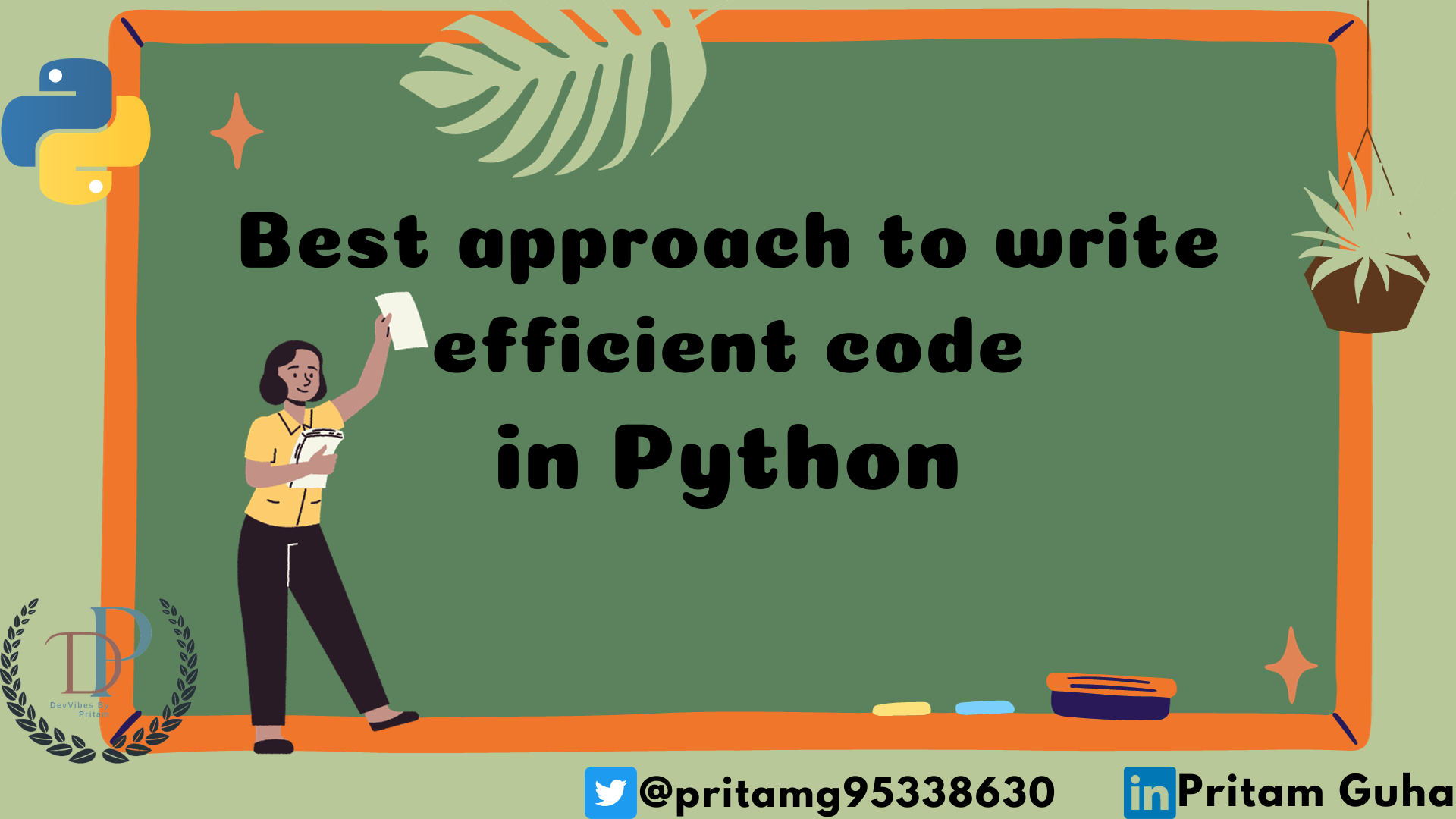Best approach to write efficient code in Python
 Cup of Solution
Cup of Solution
Introduction:
Python is known for its readability and simple of use, but it's also important to write efficient code to ensure your programs run quickly and consume minimal resources.
With this, we should remember which code will take time and memory. If we can reduce the time and memory needed to compile any code, that will be perfect for approaching the best logic.
Below are some examples to make your work more perfect.
Try to create
functions.Decrease useless
operations.Do not declare
variablesthat are not necessary.Reduce your
if-elseconditions.Replace
time with sleeptowait until.The loops should be
brokenas needed.Avoided the
global variables.convert all the big
if-elseconditions toswitch-casestatements.Use
Generatorsfor largeData Sets.
1. Creating meaningful functions:
A function is a block of code. In a function, we can use many sequences of code, and we can call the function anywhere.
Without using functions, if you write any code, it will take more time and memory. If you want to take the result of the same code without a function, you should write every time, but the function will help to reduce this.
Below, you can see the usefulness of functions and how they will help you write perfect code.
Example :
### THIS IS WITHOUT FUNCTION (1st part) ###
a = 3
b = 5
result = a + b
print(result) # This will print 8
### THIS IS WITH FUNCTION (2nd part) ###
def add_two_numbers(a, b):
result = a + b
return result
sum_result = add_two_numbers(3, 5)
print(sum_result) # This will print 8
There are two parts: one is without function, and the other is with function.
The 1st part is right, but if we take the result of this, we should write it every time.
But the 2nd part can help us reduce the time, and we can call this anywhere for a result.
2. Reduce unnecessary operations:
Many times we use unnecessary operations that may make code lengthy.
Example - 1:
### Inefficient Approach ###
a = a + b
a = a - c
### Efficient Approach ###
# Merging in the same line
a = a + (b - c)
To perform addition and subtraction simultaneously we can merge them into a single operation.
Example - 2:
Inefficient Approach:
total = 0
for num in range(1, 11):
if num % 2 == 0: # Check if the number is even
total += num
print(total)
We start with an empty variable called
totalto keep track of the sum.We use a loop to go through each number from
1 to 10.For each number, we check if it's even by using the
% (modulo)operator. The% 2operation checks if there is a remainder when dividing the number by 2. If there's no remainder, it's even.If the number is even, we add it to the
total.
This approach performs unnecessary operations.
Efficient Approach:
total = 0
for num in range(2, 11, 2):
total += num
print(total)
We still start with an empty variable called
totalto keep track of the sum.We use a loop to go through each even number from
2 to 10.We start the loop at 2 (the first even number) and increment by 2 in each step.
For each iteration, we directly add the current even number to the
totalwithout checking if it's even or not.
In simple terms, the efficient approach doesn't waste time checking if numbers are even because it already knows they are. It directly adds the even numbers to the total, making the code simpler and faster.
3. Avoiding Global Variables:
Using global variables can make code harder to work with. It's better to use local variables or function parameters for cleaner and more maintainable code.
Inefficient Approach (Using Global Variables):
length = 5
width = 3
def calculate_rectangle_area():
area = length * width
return area
result = calculate_rectangle_area()
print(f"The area of the rectangle is: {result}")
In this code, length and width is defined as global variables outside the function. The function calculate_rectangle_area uses these global variables to calculate the area of the rectangle.
Efficient Approach (Avoiding Global Variables):
def calculate_rectangle_area(length, width):
area = length * width
return area
length = 5
width = 3
result = calculate_rectangle_area(length, width)
print(f"The area of the rectangle is: {result}")
In this code, we pass length and width as parameters for the calculate_rectangle_area function, eliminating the need for global variables.
This way, the function doesn't need global variables. It works on its own using the given values to figure out the area. The function is self-contained and relies on the provided parameters to calculate the area.
It also promotes code reusability, as you can calculate the area for different rectangles by providing different values.
4. Profile Your Code:
Profiling helps you identify performance bottlenecks in your code. Python's built-in cProfile module can help you pinpoint which parts of your code need optimization.
Inefficient Approach (Manual Timing):
import time
# Function to be profiled
def slow_function():
for _ in range(1000000):
result = 2 * 2
start_time = time.time()
# Call the slow function
slow_function()
end_time = time.time()
execution_time = end_time - start_time
print(f"Execution time: {execution_time} seconds")
In this inefficient approach, we manually record the start and end times to measure the execution time of the slow_function.
Efficient Approach (Using cProfile):
import cProfile
# Function to be profiled
def slow_function():
for i in range(1000000):
result = 2 * 2
if __name__ == "__main__":
cProfile.run("slow_function()")
In this efficient approach, we use the cProfile module to profile the slow_function. It automatically records function calls, execution times, and other profiling information, providing more detailed and accurate insights into the code's performance.
Using cProfile is an efficient way to profile code because it automates the process and gives you a comprehensive view of your code's performance characteristics.
5. Reduce your use of If-Else:
If-else conditions are best to work with but the user needs to reduce the use of them or if using then use them properly and try to put the condition which has a high probability of matching first.
Inefficient Approach (With Many If-Else Statements):
product_category = "Electronics"
price = 0
if product_category == "Electronics":
price = 500
elif product_category == "Clothing":
price = 50
elif product_category == "Books":
price = 10
elif product_category == "Toys":
price = 25
elif product_category == "Furniture":
price = 1000
else:
price = 0 # Default price for unknown categories
print(f"The price of the product is: ${price}")
In this inefficient approach, we have multiple if-else statements to check the product category and set the price accordingly. This approach can become less maintainable as the number of categories grows.
Efficient Approach (Using a Dictionary):
product_category = "Electronics"
category_prices = {
"Electronics": 500,
"Clothing": 50,
"Books": 10,
"Toys": 25,
"Furniture": 1000
}
price = category_prices.get(product_category, 0)
print(f"The price of the product is: ${price}")
product_categoryrepresents the category of the product you want to determine the price for.category_pricesis a dictionary that maps product categories to their respective prices.priceis calculated by using the.get()method of the dictionary, which retrieves the price based on theproduct_category. If the category is not found in the dictionary, it defaults to a price of 0.The final line prints the calculated price, indicating the price of the product based on its category.
Subscribe to my newsletter
Read articles from Cup of Solution directly inside your inbox. Subscribe to the newsletter, and don't miss out.
Written by

Cup of Solution
Cup of Solution
I am an experienced python developer, worked on various projects which includes development and integration using python. I have started writing blogs recently to explore more of new things and technologies.